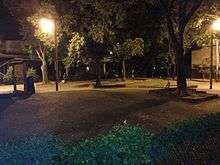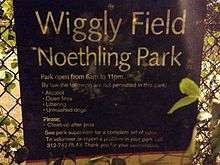Wiggly Field
Wiggly Field is a dog park on the north side of Chicago, Illinois. It was established in 1997 and was Chicago's "first official dog exercise and play area".[1] The informal name[2] Wiggly Field is a play on words for the nearby historic baseball stadium, Wrigley Field. (The dog park is not, in fact, a field.)


Founded by Stacey Hawk, Diane Dorwart and Judy Tullman,[1] the play area is part of Noethling Park of the Chicago Park District and is located at 2645 N. Sheffield Avenue (at Schubert Avenue)[3] in the Wrightwood Neighbors part of the Lincoln Park neighborhood.[2]
Wiggly Field is one of the most popular and well known of Chicago's dog parks. It has been featured on Animal Planet's show K-9 to 5, in Chicago magazine (July 1999), InStyle magazine (September 2000), Bark Magazine (Spring 2002), and Chicagoland Tails (2002).[1] Wiggly Field was named one of the top ten US dog parks by Dog Fancy magazine readers.[4]
Noethling Park itself was established by the Chicago Park District in 1970. It is named for Grace Noethling, founder of the Wrightwood Neighbors Conservation Association.[2]
Notes
- Wiggly Field profile at WrightwoodNeighbors.org
- [http://www.chicagoparkdistrict.com/index.cfm/fuseaction/parks.detail/object_id/4253C094-3128-4548-9CBA-EB2AF2EDA24F.cfm Wiggly Field/Noethling Park] at the Chicago Park District website
- "Google Maps".
- Dog Park Winners 2005 at Dog Fancy
External links
- Wiggly Field (Noethling Park) at the Chicago Park District website
- Noethling Park Dog Park at dogfriendly.com